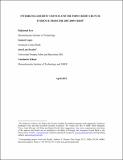Interbank Liquidity Crunch and the Firm Credit Crunch: Evidence from the 2007-2009 Crisis
Author(s)
Iyer, Rajkamal; Peydro, Jose-Luis; da-Rocha-Lopes, Samuel; Schoar, Antoinette
DownloadIyer_Interbank liquidity.pdf (711.5Kb)
OPEN_ACCESS_POLICY
Open Access Policy
Creative Commons Attribution-Noncommercial-Share Alike
Terms of use
Metadata
Show full item recordAbstract
We study the credit supply effects of the unexpected freeze of the European interbank market, using exhaustive Portuguese loan-level data. We find that banks that rely more on interbank borrowing before the crisis decrease their credit supply more during the crisis. The credit supply reduction is stronger for firms that are smaller, with weaker banking relationships. Small firms cannot compensate the credit crunch with other sources of debt. Furthermore, the impact of illiquidity on the credit crunch is stronger for less solvent banks. Finally, we find no overall positive effects of central bank liquidity but instead higher hoarding of liquidity.
Date issued
2013-10Department
Sloan School of ManagementJournal
Review of Financial Studies
Publisher
Oxford University Press on behalf of The Society for Financial Studies
Citation
Iyer, R., J.-L. Peydro, S. da-Rocha-Lopes, and A. Schoar. “Interbank Liquidity Crunch and the Firm Credit Crunch: Evidence from the 2007-2009 Crisis.” Review of Financial Studies 27, no. 1 (January 1, 2014): 347–372.
Version: Author's final manuscript
ISSN
0893-9454
1465-7368